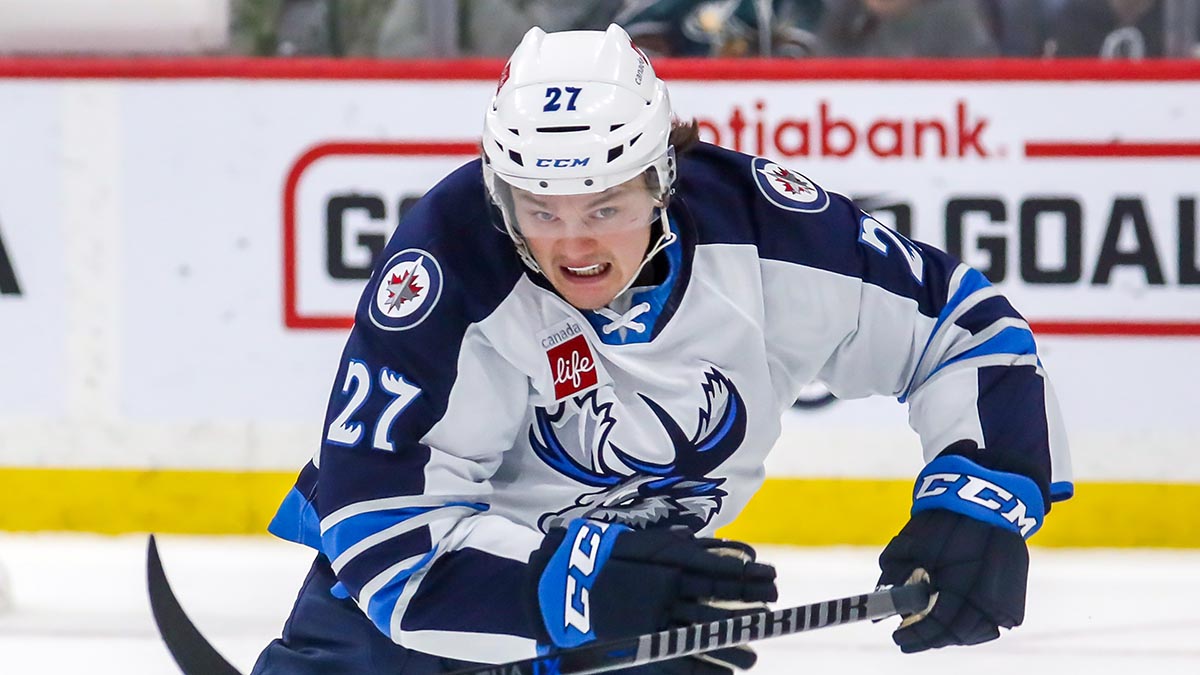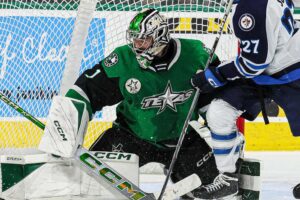📝 by Daniel Fink | AHL On The Beat
The threat of a serious injury is an ever-present reality in hockey. Players who experience such setbacks are in for weeks, perhaps months, of recovery, rehab and getting back up to playing speed.
Manitoba Moose forward Luke Johnson went through this process after breaking his leg in the fifth game of the regular season. His recovery lasted just shy of 11 weeks.
Then, just six games into his return, the unthinkable occurred. On a seemingly innocent play in Iowa on Jan. 19, Johnson broke the same leg, beginning another 10 weeks of recovery.
“I was getting flashbacks to when it happened the first time,” Johnson recalled. “Right away I knew what the process would be like as far as recovery and all that. It was a tough pill to swallow.”
That knowledge comes as a bit of a double-edged sword. On one hand, Johnson knew and understood what his next 10 or more weeks would look like. On the other, he knew exactly what obstacles and frustration he was in for through the recovery process.
“Obviously getting hurt the first time you’re out for quite some time. Then, come back, play five games and do it again. It’s just… it’s tough mentally. You just want to play and I knew the road to recovery was going to be a long one.”
Seeing Johnson unable to get back to the bench under his own power was a shocking and painful moment for his teammates, coaches and everyone else who had worked with the forward to get him back in the lineup.
“You could sense on the bench the sort of heartbreak when we saw him struggle to get back up,” remembered assistant coach Marty Johnston. “We were just kind of heartbroken for Luke based on the amount of work he did to get back and how tough he is. It was a down moment for our group for sure.”
Many of Johnson’s teammates understood what he faced through the recovery process. They knew exactly what struggles the Grand Forks, N.D., product battled through to get back to the lineup. They had celebrated his return and watched as Johnson flew out of the gate with points in each of his first five games back, including a crucial game-winning goal in Milwaukee on Jan. 12. Then, just like that, it was starting all over again.
“For some of the guys who went through a big injury, the first time, you get sick to your stomach. So when it happens in the sixth game and he gets injured again it’s just…” Moose captain Jimmy Oligny said trailing off, shaking his head. “We all know (Johnson) would play through any kind of little injuries. He’s a warrior. For another big injury to happen like that to him, we felt bad for him and it was a huge loss for our team.”

The Road Back, Again
Johnson’s second trip on the road to recovery started under difficult circumstances. The team was already buffeted by numerous absences due to call-ups and COVID-19. In a normal situation, the first person on the scene would be Moose head athletic therapist Zach Salmonson. However, coming off his own bout with COVID-19, Salmonson couldn’t be on the bench or in the dressing room when Johnson went down.
Despite not being on the ice, Salmonson was still able to help coordinate with assistant athletic therapists Kyle Vouriot and Will Sadonick-Carriere and the Iowa Wild medical staff. By the end of the night, Johnson was able to travel back to Winnipeg with the team.
There were differences between the two recovery processes. The first time Johnson was injured, he didn’t undergo surgery. As a result, the recovery timeline was somewhat hazy to begin. Surgery was involved in the second instance, leading to a more concrete timeline.
From the outset, one of the obvious problems with any lower-body injury is players can’t skate and large portions of cardio options are off the table. Meanwhile, spending a month or more in a walking boot atrophies muscles in the leg.
“By the time you’re allowed to get out of the boot, you’re not starting from where you’d start at the beginning of the season. You’re starting from such a deficit,” Salmonson explained. “So that six or seven weeks, it’s all upper-body and trying to find ways to do cardio. You’re trying to maybe ride a (stationary) bike with a boot. You’re doing ropes. You’re doing as much upper-body cardio as possible to keep the systems running.”
Once out of the boot it’s time for some very incremental progress. Days are spent at the rink working on building strength back in the leg. From busy days at the team’s practice facility when the Moose are home and the whole team is in the building, to one-on-one work with Sadonick-Carriere while the team is on the road.
Some days will be easier than others and it’s a fine balance for the training staff between encouraging players like Johnson and not pushing too hard. The process breaks into daily goals and celebrating each step forward.
“There’s so much of a psychological side players have to battle through. It’s a struggle,” added Salmonson. “You have to break it up into these little, tiny victories so the psychological game doesn’t take over and you’re battling more demons than you need to.”
In Johnson’s case, going through the whole ordeal twice in quick succession made for a more difficult time mentally.
“The first time, it is what it is,” said Johnson. “Everyone deals with injuries in their career. You have to do what you can to keep yourself in a good head space off the ice. So the first time was definitely tough, but the second time I think was a lot tougher. You’re having to go through it again and missing such a big part of the season.”
Through it all, Johnson maintained an upbeat outlook and remained a strong influence as part of a very tight-knit Moose team. Johnson’s teammates and coaches made sure the process wasn’t entirely his load to bear.
“We try to do stuff as a team when we’re at home because (injured players) don’t follow the team when we’re on the road and they’re just beginning their rehab,” said Oligny, the team’s first-year captain. “It’s fun to come to Iceplex; (Luke) is always there early so he sees everybody. We also do a couple team events. Everybody tries to check in every once and a while as well.”
Keeping injured players engaged isn’t anything new, but it’s still difficult when hockey players can’t do what they’re best at. During Johnson’s second stint on the injured reserve, the Moose landed on a unique solution.
Coach Johnson?
Johnson began assisting in an informal player-coach role during his second extended absence from the lineup. He watched games in person, or on AHLTV when the team was on the road, and took notes for the coaching staff. Johnson worked especially close with assistant coach Marty Johnston who runs the Manitoba power play.
“We had discussions post-game on what he saw and tried to develop a bit of a plan in terms of thinking like a coach and player at the same time and providing feedback,” coach Johnston explained. “We had him sitting in on meetings, so he knew the direction of where the team was going. I think that helped him feel part of it.”
Johnston was impressed by how the sixth-year pro took to the coaching side of things. The Moose assistant coach lauded Johnson’s ability to see intricate details, but also keep everything simple when returning with feedback. It shouldn’t be too much of a surprise seeing as Johnson has coaching in his blood, so to speak.
Luke’s father, Steve Johnson, was the head coach of the USHL’s Lincoln Stars from 1996-2007. That decade in Lincoln yielded two championships and another appearance in the finals. He also guided the Fargo Force to a USHL finals appearance during the 2009-10 season before moving to the NCAA as an assistant coach with St. Could State (2010-12) and the University of Nebraska-Omaha (2012-13). As a result, the younger Johnson feels he has a bit of a different perspective on the game.
“I always saw the game differently than maybe most players, just because of having my dad as a coach you see things differently. It’s something I’ve always had in the back of my mind. I never thought an opportunity like this would come this early, but it’s definitely something I think I’d enjoy after my playing days.”
In addition to giving Johnson something to focus on other than rehabbing his injury, the player’s time helping off the ice gave the coaching staff a new strategy for the future.
“It certainly helped me as well to get a player’s perspective,” coach Johnston added. “It was a really good experience and I think we’ll use it if this has to happen again.”
Back in Action
On March 29, following a couple weeks back skating with the team and 10 weeks since breaking his leg for the second time, Luke Johnson returned to the Moose lineup. The gritty forward wasted no time in pasting a Laval Rocket defender to the boards on his first shift. He went on to record two shots on goal and provided an assist on a crucial power play goal early in the third period. The Moose eventually came out with a 4-3 shootout victory on home ice. For Johnson, it was the payoff from months of work.
“I felt pretty good coming back. It was definitely exciting, but was just trying to shake some rust off. Even now, still just trying to get that rust off and get back to feeling good before playoffs.”
After witnessing Johnson’s battle throughout the season, there are still some nerves for the training staff when seeing him in game action.

“I cringe. I still do,” laughed Salmonson. “Because of… everything. You don’t want him to miss any more time. He’s a good player for us. He’s a good guy to have around the room, on the road, everywhere. He’s a good role model for these guys. He’s been around the league for a long time. You want nothing but good things to happen.”
Getting a little better every day is still the goal for Johnson as the 2022 Calder Cup Playoffs approach. As he fully rounds back into form the team is happy to have that experience back in the lineup and to see the forward back doing what he loves.
“We’re pumped,” grinned Oligny. “He’s a big piece in our locker room and on the ice too. You’re never going to see him turn away from a guy. He’s always going to finish his hits. He’s always going to play hard. I think he’s one of the guys our younger players should look up to because that’s how the game should be played.”
On a young Moose team, 13 games of Calder Cup Playoff experiences makes Johnson one of the most playoff-savvy players in the lineup. That includes posting three assists in four games against the Moose during the Central Division Finals in 2018 while skating for the Rockford IceHogs.
“He has a level of toughness you don’t see on the stat sheet that helps our group,” said coach Johnston. “We’re really excited to see him back and the players feel the same way.”
There’s excitement throughout the team with the focus squarely on clinching home-ice advantage in the first round of the playoffs and looking to the post-season. After missing over 20 weeks of the season due to injury it’s Luke Johnson’s reward at the end of a difficult road and an opportunity to rise to the occasion.
“It’s a fun time. It’s exciting and we have a good team. We’re all just kind of chomping at the bit now to get going. We’re looking forward to it.”






































